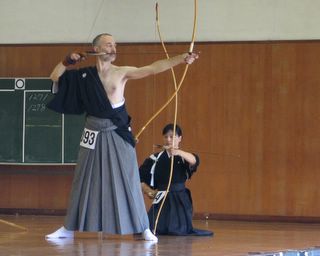
The bow and arrow began to be used more than 10,000 years ago for hunting and in war. In the Nara (710-794) and Heian (794-1185) periods they were utilized in rituals dedicated to the gods; it was around this time that archery made its appearance in events held at the Imperial court.
In 1543 firearms were introduced to Japan by a shipwrecked Portuguese who landed on Tanegashima, an island off Kyushu that's part of present-day Kagoshima Prefecture. After this, the role of the bow and arrow in battle declined, but as members of the ruling class, warriors continued to train themselves in archery--called kyudo in Japanese, meaning "the way of the bow"--because they considered it important as a mark of their refinement.
National ChanpionshipAn event called toshiya was held during the Edo period (1603-1868) at Sanjusangendo (the main hall of the temple Rengeoin in Kyoto) in which warriors would compete in archery to see who had the greatest physical and mental strength.They would try to shoot arrows through the length of the long, narrow hall--2.2 meters (2.4 yards) wide, 5 meters (5.5 yards) high, and 120 meters (131 yards) long--without hitting the walls, floor, or ceiling. What's more, each contestant would have to spend an entire day and night shooting arrows in sitting position.
Warriors who were confident of their archery skills would enter the contest and compete to see who could make the most good shots. The best archer in toshiya was Wasa Daihachiro of the Kishu clan, who took 13,053 shots in a single contest, out of which 8,133 were successful.

In the Meiji era (1868-1912) kyudo was brought into the school curriculum, and today many universities, high schools, and middle schools offer archery instruction either in class or as an extracurricular activity. Since archers can adjust the tension of the bow according to their own strength, kyudo is popular as a sport that men and women of all ages can enjoy.
The pictures above have been taken during a tournament in Meiji Jingu.
No comments:
Post a Comment